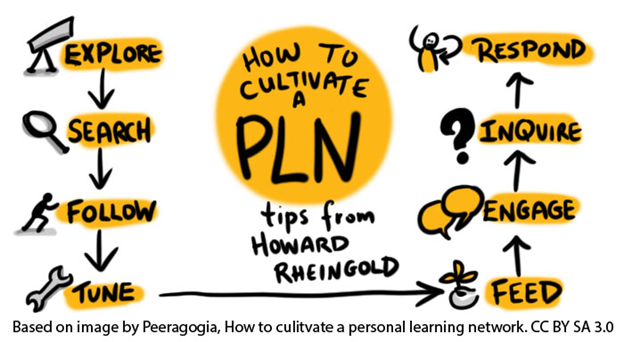Collaborator
Collaborator
Extend: Cultivate a PLN
A personal learning network, although often emergent and continually developing, does not just happen. It requires cultivation. To begin your thinking on how to cultivate your PLN, read Howard Rheingold’s Advice on Building a PLN.

Start cultivating your PLN
- Find a professional group or individuals who align with your professional interests. Start by reviewing Twitter EdChat calendar and Inside Higher Ed’s Twitter Directory. Find the virtual places that feel most comfortable and sustainable for you. Go where your people are, be strategic, and take your cues from people in your network. For example, if you notice at a conference that several presenters are posting their Twitter account names, then Twitter is likely the place where others will be found. Or perhaps the common gathering place for your discipline is something other than Twitter, such as Facebook, LinkedIn, Instagram or a Slack workspace. See also the Twitter list of people and organizations related to Ontario Extend for possible accounts to follow, as well as a visualization of the Extend Twitter Network.
- Represent new additions to your PLN. Now, using the Extend Toolkit find a creative visual way to showcase/illustrate which professional group aligns most to your professional interests.
- Share your visualization as a response to the Cultivate Your PLN activity.
As evidence of completion, please plan to enter the web address for your response in the Collaborator badge submission form.
- Strengthen your connections. Comment on and share the work of others and contribute your own work or ideas. Gather and follow the people and organizations that push you to extend your thinking and move out of your comfort zone. That is key to creating a sustainable PLN—one that will help you develop and feel inspired
- Limit your ‘follows’ to topics you are passionate about. Cull your follows once in a while to refocus your stream.
- Consider the identity that you are creating within the network. In a post about “Becoming a Connected Educator” Mary Wever (@WeverWorld), Director of Certificate Programs for Michigan State University’s MA in Educational Technology suggests that you:
“Consider the professional identity you want to project on social media and in your PLN. What you post, share, or like online becomes part of your identity in a way. Some people feel more or less comfortable with using their personal accounts for professional activities, and vice versa. It is a good idea to think about what you envision your PLN to be like before diving into it”. (Source: http://insideteaching.grad.msu.edu/becoming-a-connected-educator-building-your-personal-learning-network-pln/)
- Always use “netiquette”; acknowledge the contributions of others.
- Think before you share; be consistent with the identity you are projecting
Beware of filter bubbles
The term “filter bubbles” was coined by Eli Parser. Read the Wikipedia article about Filter Bubbles or take a look at his TED Talk, Beware of Online Filter Bubbles (TED2011) perhaps even more relevant now, six years later.

It is important to follow and connect with a variety of people and organizations. Because you will choose who you want to follow—usually like-minded individuals—social media can give you an unbalanced view. It is important to include people you do not agree with. Doing so will make your PLN more diverse and will challenge your thinking.
In their book The Power of Pull: How Smart Moves, Smartly Made, Can Set Big Things in Motion, by John Haagel, John Brown, and Lang Davison stress the importance of reaching outside your usual areas of interest and expertise. Doing so will stretch you and help you avoid the insularity that can come from too much time spent in your own milieu, with only those who share your own interests.
Building your PLN
There are tools (see the Extend Toolkit) and social media platforms that you might use to build your PLN. Leveraging the affordances of digital technologies means that the tools and activities you can engage with and use to build your learning network can take on vastly different forms. You might share something you have authored within your network and get feedback on what you have done from a variety of perspectives. Or you might be inspired by a provocative blog post that someone else in your network has posted. Or you might put out a call for collaborators on a new project, or join a group discussion, or remix someone else’s work as a way of extending their ideas—and the conversation about it. While digital technologies are not required for these learning activities to happen, they enable you to engage with them in novel and more expansive ways.
You might seek out specific venues where you can build your PLN, like conferences, or you might join social media groups related to your discipline to get started. Twitter is particularly valuable for building a personal learning network, as noted by in Starting a PLN on Twitter: A Quick Guide For Teachers by Common Sense Education.

Extend Community

Visit the Extend Community Space Expanding Your PLN discussion area (in the #collaborator channel) to share strategies that you have tried to cultivate and expand your PLN.




